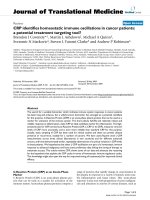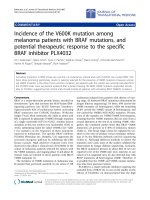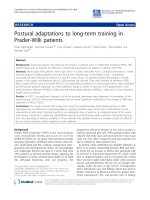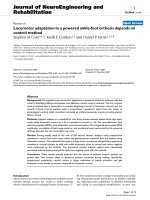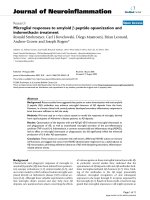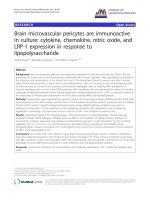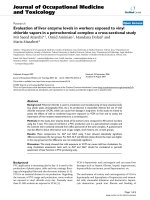Báo cáo hóa học: " Postural adaptations to long-term training in Prader-Willi patients" pdf
Bạn đang xem bản rút gọn của tài liệu. Xem và tải ngay bản đầy đủ của tài liệu tại đây (246.39 KB, 6 trang )
RESEARCH Open Access
Postural adaptations to long-term training in
Prader-Willi patients
Paolo Capodaglio
1
, Veronica Cimolin
1,2*
, Luca Vismara
1
, Graziano Grugni
3
, Cinzia Parisio
1
, Olivia Sibilia
1
and
Manuela Galli
2,4
Abstract
Background: Improving balance and reducing risk of falls is a relevant issue in Prader-Willi Syndrome (PWS). The
present study aims to quantify the ef fect of a mixed training program on balance in patients with PWS.
Methods: Eleven adult PWS patients (mean age: 33.8 ± 4.3 years; mean BMI: 43.3 ± 5.9 Kg/m2) attended a 2-week
training program including balance exercises during their hospital stay. At discharge, Group 1 (6 patients)
continued the same exercises at home for 6 months, while Group 2 (5 patients) quitted the program. In both
groups, a low-calorie, well-balanced diet of 1.200 kcal/day was advised . They were assessed at admission (PRE),
after 2 weeks (POST1) and at 6-month (POST2). The assessment consisted of a clinical examination, video recording
and 60-second postural evaluation on a force platform. Range of center of pressure (CoP) displacement in the
antero-posterior direction (RANGE
AP
index) and the medio-lateral direction (RANGE
ML
index) and its total trajectory
length were computed.
Results: At POST1, no significant changes in all of the postural parameters were observed. At completion of the
home program (POST2), the postural assessment did not reveal significant modifications. No changes in BMI were
observed in PWS at POST2.
Conclusions: Our results showed that a long-term mixed, but predominantly home-based training on PWS
individuals was not effective in improving balance capacity. Possible causes of the lack of effectiveness of our
intervention include lack of training specificity, an inadequate dose of exercise, an underestimation of the neural
and sensory component in planning rehabilitation exercise and failed body weight reduction during the training.
Also, the physiology of balance instability in these patients may possibly compose a complex puzzle not affected
by our exercise training, mainly targeting muscle weakness.
Background
Prader-Willi syndrome (PWS) is the most frequent
cause of syndromic obesity and occurs in 1 in every
25,000 live births [1]. Its major clinical features include
muscular hypotonia, childhood-onset obesity, short sta-
ture, small hands and feet, scoliosis, osteoporosis, hypo-
gonadism and developmental delays [2]. Hyperphagia
and weight gain between the ages of 1 and 6, lead most
PWS patients to develop morbid obesity, affe cting the
development of motor and functional skills [3]. In adult
life, although hypotonia does not progress, the
progressive effects of obesity on the joints produce a
cautious abnormal gait [4,5]. PWS patients present with
reduced lean body mass and increased fat to lean mass
ratio not only when compared with lean patients but
also in relation to obese patients [6,7].
In general, obese individuals are typically sedentary as
there is an inverse relationship between BMI and activ-
ity levels [8]. An increase in BMI is also associated with
an increase in functional impairment [9], which c ould
lead to impaired balance and an increased risk of falls
than normal-weight individuals under daily postural
stresses and perturbations [10,11], even in younger indi-
viduals, under 40 years of age [12,13]. Consequently,
obese individuals may fear falling, which may lead to
further reductions in physical activity [8], greater func-
tional impairment [14], and greater risk of falling.
* Correspondence:
1
Orthopaedic Rehabilitation Unit and Clinical Lab for Gait Analysis and
Posture, Ospedale San Giuseppe, Istituto Auxologico Italiano, IRCCS, Via
Cadorna 90, I-28824, Piancavallo (VB), Italy
Full list of author information is available at the end of the article
Capodaglio et al. Journal of NeuroEngineering and Rehabilitation 2011, 8:26
/>JNER
JOURNAL OF NEUROENGINEERING
AND REHABILITATION
© 2011 Capodaglio et al; licensee BioMed Central Ltd. This is an Open Access article distributed under the term s of the Creative
Commons Attribution License ( which permits unrestricted use , distribution, and
reproduction in any medium, provided the original work is properly cited.
Obesity associated with PWS is often massive and many
individuals exceed by more than 200% their ideal body
weight. In addition to that and muscular hypotonia,
PWS show dysmorphic features that can affect postural
stability, as short stature, small hands and feet, scoliosis
and in fact they show a poorer balance capacity than
their non-genetically obese counterparts [15]. It is there-
fore not surprisingly that fracture risk is approximately
50% in children [16] and more than 30% in adults [17].
The issue of whether rehabilitation interventions may
improve balance and decrease risk of fall in PWS
appears therefore certainly clinically relevant.
In a previous study [15], we demonstrated that PWS
patients have a poorer balance capacity than their non-
genetically obese counterparts and our findings sug-
gested that strengthening of ankle flexors/extensors, bal-
ance training and tailored exercises aimed at improving
medial-lateral control using hip strategies should be
given particular consideration within rehabilitation
programs.
Benefits from specific posture programs designed to
improve balance and strength have been documented in
obese patients [18], and weight reduction programs have
a favorable impact on posture instability [13]. Maffiuletti
et al [12] investigated the effect of a 3-week weight
reduction program plus specific balance training on pos-
tural stability in extremely obese individuals. They
demonstrated that a weight reduction program asso-
ciated with a specific balance training was significantly
more effective than the first alone. To our knowledge,
no studies have quantitatively evaluated the effects of a
training program on balance in PWS patients.
Vismara et al [19] have demonstrated t hat long-term
group interventions (6 months) are feasible in PWS,
despite their particular psychological profile, and effec-
tive in improving muscle strength and gait strategy.
The aim of this investigation was therefore to evaluate
the effectiveness of a mixed exercise program, partially
supervised and partially home-based, on postural stabi-
lity in PWS adults.
Methods
Participants
We enrolled 11 adult patients with PWS (age: 33.8 ± 4.3
years; BMI: 43.3 ± 5.9 kg/m2) admitted to our rehabili-
tation hospital. Physical examination included determi-
nation of height and weight under fasting conditions
and after voiding. BMI was defined as weight/height
2
(kg/m
2
). All patients showed the typical PWS clinical
phenotype [20]. Cytogenetic analysis was performed in
all participants; 10 had interstitial deletion of the proxi -
mal long arm of chromosome 15 (del15q11-q13). More-
over, uniparental maternal disomy for chromosome 15
(UPD15) was found in 1 female.
All PWS subjects showed mild mental retardation. One
of the admission criteria for the study was a score over
the cut-off value of 24 in the Mini Mental State Examina-
tion (MMSE) Ita lian version [21]. Scores over the MMSE
cut-off suggest the absence of widespread acquired cogni-
tive disorders in adult people. Our PWS patients were all
able to understand and complete the testing.
The control group included 20 healthy individuals
(CG: 10 females and 10 males; BMI: 2 1.6 ± 1.6 kg/m2;
age: 30.5 ± 5.3 years). All participants were free from
conditions associated with impaired balance. We clini-
cally examined the experimental subjects to exclude
individuals with vision loss/alteration, vestibular impair-
ments, neuropathy and those who reported symptoms
related to intracranial hypertension. All PWS and CG
had normal values in the main laboratory tests, includ-
ing adrenal and thyroid function. The study was
approved by the Ethics Research Committee of the Insti-
tute. Written informed consent was obtained by
patients, where applicable or their parents.
Intervention
On admission, all patients underwent a clinical assess-
ment. During their hospital stay, they attended a 2-week
training program which included supervised exercise
sessions with specific muscle strengthening of the lower
limb s and 30-45 min aerobic walking sessions. All these
sessions were held 4 days per week and included an
introductory talk aimed at educating patients about the
obesity-related changes in gait and posture and at pro-
viding practical information about their rehabilitation
program. The sessions consisted of 4 exercises,
explained as follows:
1) “Standupagainstthewallwithoutlettingyour
heels touch it, bend at your knees to 90° as if you
wereabouttositdown,thenslowlyreturntothe
upright position";
2) “Stand up against the wall and then alternately lift
your toes upwards";
3) “From a standing position, raise yourself up onto
your toes and then slowly lower your heels back to
the ground";
4) “Walk on your heels at a comfortable speed and
don’t let the rest of your feet touch the floor”.
For exercises 1, 2, and 3 patients were asked to com-
plete 3 sets of 15 repetitions each. For exercise 4,
patients were asked to walk approximately 4 metres and
then repeat the task 10 times with a rest in-between.
They were instructed to perform the exercise program
at home 3 times a week for 6 months. Patients were
required to keep a daily record of their adherence to the
program.
Capodaglio et al. Journal of NeuroEngineering and Rehabilitation 2011, 8:26
/>Page 2 of 6
At discharge, Group 1 (6 patients) continued the same
4 exercises unsupervised at home for 6 months, while
Group 2 (5 patients) did not undergo the training pro-
gram, according to a deliberate experimental design. In
all subjects, a low-calorie, well-balanced diet of 1.200
kcal/day was advised during hospital stay and the 6-
month home-training. Historically, the calorie require-
ment to maintain weight in adults with PWS is about
60% of normal, and a low calorie, well-balanced diet of
1,000-1,200 kcal/day combined with re gular exercise
should be advised [22]. Furthermore, a general recom-
mendation to obtain weight loss has been from 800 to
1.000 kcal/day. In this light, adherence to these calorie-
restricted diets requires intensive and continuous moni-
toring of intake by caregivers and regular dietary
counselling.
Methods
Subjects were assessed on admission (PRE), at discharge
after 2 weeks (POST1) and after the 6-month training
program (POST2). The assessment consisted of a clini-
cal examination, video recording and postural
evaluation.
The postural evaluation was conducted with a force
platform (Kistler, CH; acquisition frequency: 500 Hz)
integrated with a video system. The output of the force
platform are three orthogonal components of ground
reaction force (F
ML
, i.e. the component of ground reac-
tion force in the medio-lateral direction, F
AP
,i.e.the
component of ground reaction force in the antero-pos-
terior direction; F
V
, i.e. the compone nt of ground reac-
tion force in vertical direction), a torsion moment, and
the coordinate of Centre of Pressure (CoP) (CoP
ML
,i.e.
the component of CoP displacement in the M/L direc-
tion and CoP
AP
, i.e. the component of CoP displacement
in the A/P direction) on the horizontal plane.
The individuals were instructed to maintain an
upright standing position for 60 seconds with open
eyes (OE) focusing on a 6 cm black circle positioned
at the individual line of vision at a distance of 1.5 m.
Arms were hanging by their sides and feet were posi-
tioned at an angle of 30° with respect to the A/P direc-
tion. To standardize the experimental position, a
triangle was located between the feet and removed just
before acquisition. To avoid any kind of learning or
fatigue effect [23] only one trial was acquired in this
study for each session.
Data analysis
The outputs of the force platform allowed us to com-
pute the CoP time series in the A/P direction (CoP
AP
)
and the M/L direction (CoP
ML
). The first 10s interval
was discarded in order to avoid the transition phase in
reaching the postural steady state [24].
In accordance with the literature [11] the following
parameters were computed as significant for the pos-
tural analysis:
• RANGE: the range of CoP displacement in the A/P
direction (RANGE
AP
index) and t he M/L direction
(RANGE
ML
index), expressed in mm;
• Sway Path (SP): the total CoP trajectory length,
expressed in mm.
All parameters were normalized to the participant’s
height (expressed in meters), according to literature
[25], in order to avoid the influence of different subject’s
height on the results.
Statistical analysis
All the previously defined parameters were computed
for each participant and then the mean values and stan-
dard deviations of all indexes were calculated for each
sessions in PWS and for CG. Data of all patients were
compared using Wilcoxon matched pair test, to detect
significant PRE-POST1 differences; the same test was
used to compared POST1 and POST2 of Group 1 and
Group 2, considering each group separately. PWS and
CG data were compared with Mann-Whitney U tests.
Null hypotheses were rejected when probabilities were
below 0.05.
Results
In Table I, mean and standard deviation values for each
postural parameter are displayed at PRE and POST1 for
PWS and CG. The reported values were normalised for
individual height (expressed in meters).
At PRE, the analysed parameters were statistically
different in PWS and CG, suggesting that PWS
patients did not present a physiological postural strat-
egy. PWS individuals showed greater displacements
along both the A/P and the M/L direction in terms of
RANGE, in line with previous observations [12], and a
longer SP than CG.
At POST1, no significant changes were obser ved in all
of the parameters (Ta ble 1) and BMI was similar to
those observed at PRE session (43.04 ± 7.43 kg/m
2
).
At POST2, Group 1 (6 patients, undergoing the reha-
bilitative treatment at home for 6 months) and Group 2
Table 1 Postural parameters of PWS at PRE and POST1
PRE POST1 CG
RANGE
AP
19.04 (6.76)* 17.67 (5.24)* 5.03 (2.65)
RANGE
ML
14.79 (9.53)* 12.59 (5.21)* 9.36 (3.53)
SP 573.58 (86.19)* 513.03 (80.90)* 201.33 (45.86)
Data are expressed as mea n (sta ndard deviation) (expressed in mm) and are
normalised to the participant’s height (expressed in meters). CG: Control
group. * = p < 0.05, PRE and POST1 versus CG.
Capodaglio et al. Journal of NeuroEngineering and Rehabilitation 2011, 8:26
/>Page 3 of 6
(5 patients, non exercising after the completion of the 2-
week supervised program) were compared. The adher-
ence to the home-based program, computed as the per-
centage of number of sessions performed/number of
total sessions, was 90%. The postural condition of both
groups of PWS patients were unchanged (Figure 1,
Figure 2), maintainin g the higher values for RA NGE
AP
and RANGE
ML
parameters. The SP did not differ signif-
icantly both in GROUP1 (498.74 ± 70.26 vs. 469.53 ±
58.67; p > 0.05) and in GROUP2 (527.32 ± 91-18 vs.
506.63 ± 90.92; p > 0.05), too.
At POST2, BMI was similar to those observed in basal
condition both in GROUP1 (40.38 ± 3.46 kg/m
2
vs.
42.57 ± 4.92 kg/m
2
; p > 0.05) and in GROUP2 (42.54 ±
7.69 kg/m
2
vs. 38.35 ± 2.13 kg/m
2
; p > 0.05).
Discussion
The issue of whether rehabilitation interventions may
improve balance and decrease risk of fall in PWS cer-
tainly appears clinically relevant. PWS patients are char-
acterized by an increase in BMI which is demonstrated
to be associated with an increase in functional impair-
ment [9], which could lead to impaired balance and an
increased risk of falls. As obese individuals generally fear
falling, further reductions in physical activity [8], greater
functional impairment [14],andgreaterriskoffalling
may occur.
Based on a recent study of our group on PWS [19]
showing that long-term strengthening and gait training is
feasible and effective, with the present investigation we
aimed to verify if th e reduced balanc e could be amended
by specific training. For PWS, providing an effective and
simple home-based training would represent a conti-
nuum of the rehabilitation process outside the hospital
which appears crucial in all chronic conditions. Given the
psychological profile o f PWS individuals, training
sessions should be kept simple and reasonably short to
guarantee compliance to the program. The exercises we
prescribed were simple, clearly explained and did not
exceed a total of 30 min/day. Also, patients had been pre-
viously familiarized with the exercises and super vised for
2 weeks in order to make sure they would be able to per-
form them properly at home in the f ollowing 6-month
training period.
Our initial hypothesis was t hat balance is mainly
reduced in PWS because of muscle weakness [7] and
our training addressed the muscle groups that had been
found to be mainly respo nsible for gait diso rders [5]. In
particular our training focused on ankle flexor and
extensor muscle groups but did not include specific bal-
ance and proprioceptive exercises. A main reason for
that was to provide simple and repetitive exercises, con-
fined in a limited lapse of time, to be safely rehearsed
by the patients at home. Adding diverse exercises might
have jeopardized compliance in patients who psycholo-
gically need reassuring repetitive tasks.
Unfortunately, our results suggest that, unlike our pre-
vious positive results in strength gain and gait improve-
ment [19] and despi te a high adherence to the program,
no postural adaptations occur after a long-term, mainly
home-based strength training of the lower limb muscles.
We have chosen this type of intervention on the basis of
the known reduced muscle tonus and strength in PWS,
which have been acknowledged as major causes of
poorer balance.
A possible bias of our study is the relatively small
sample size, although it should be reminded that PWS
is a rare condition and large experimental groups are
difficult to gather. As overweight is a distinctive feature
in PWS, the analysis should have been more rigorously
compared with obese instead of normal-weight indivi-
duals. However, the main object of our investigation
was t o assess quantitatively the effect of a mixed
GROUP 1
0
5
10
15
20
25
RANGE_M L RANGE_AP
POS T1 POS T2 CG
* * * *
Figure 1 Postural parameters of GROUP1 at POST1 and POST2.
Data are expressed as mean (standard deviation) (expressed in mm)
and are normalised to the participant’s height (expressed in meters).
CG: Control group. * = p < 0.05, POST1 and POST2 versus CG.
GROUP 2
0
5
10
15
20
25
RANGE_M L RANGE_AP
POS T 1 POS T2 CG
* * * *
Figure 2 Postural parameters of GROUP2 at POST1 and POST2.
Data are expressed as mean (standard deviation) (expressed in mm)
and are normalised to the participant’s height (expressed in meters).
CG: Control group. * = p < 0.05, POST1 and POST2 versus CG.
Capodaglio et al. Journal of NeuroEngineering and Rehabilitation 2011, 8:26
/>Page 4 of 6
training program on balance in patients with PWS. Also,
the low intensity of the home-base d program may have
played a role in the negative results. Although exercise
intensity at home was not measured, anti-gravit y resis-
tance exercises in subjects with an excess in body mass
should provide adequate exercise intensity for t he aim
of improving function. Intensities as low as 60% of the
maximum voluntary contraction have indeed proved to
be an effe ctive stimulus for strength and function gain
in elderly subjects [26]. Apart from muscle weakness,
the control of stability and posture requires a complex
interaction of both the musculoskeletal and neural sys-
tem. Balance capacity is also secondary to body align-
ment and muscle tone. The first factor can in fact
minim ise the effect of gravitational forces while the sec-
ond counteracts gravity. Postural tone is fine tuned,
among other factors, by intrinsic stiffness of the muscles
and neural drive. Sensory/perceptual processes, invol-
ving the organisation and integration of visual, vestibular
and proprioceptive systems also play a role. It can be
speculated that our exercise program may have lacked
of specificity with regard to balance and oversimplified
the functions to be trained, mainly targeting muscle
strengthening and sensory-motor integration. Also, the
dose of exercise, in terms of intensity and duration of
the program, could represent a possible cause of the
lack of effectiveness of the training.
Our results are in contrast with those obtained by
Maffiuletti et al [12] on morbidly obese individuals. In
their study, specific balance training, in addition to a
body weight reductio n program, improved significantly
the postural strategy o f these patients. In our study,
training was indeed associated to the administration of a
hypocaloric diet, but weight reduction is diffic ult to
achieve in adults PWS due to their insatiable appetite
and food-seeking b ehavior. It could be speculated that
weight loss in addition to specific balance training is
mandatory in order to improve balance capacity in
PWS.
Baseline postural capacity is different in the two popu-
lations, with PWS patients generally characterized by
poorer balance than their non-genetically counterparts.
The mechanisms underlying this reduced capacity have
not been thoroughly investigated i n PWS. Future
research will need to address quality and quantity of
exercises targeted at improving balance capacity in PWS
as well as to unveil the physiological determinants of
instability in PWS.
Conclusions
In this study we evaluated quantitatively the effective-
ness of a mixed exercise program, partially supervised
and partially home-based, o n postural stability in PWS
adults. Our results suggest that no postural adaptations
occur after this program, unlike our previous positive
results in strength gain and gait improvement and
despiteahighadherencetotheprogram.Probablythe
low dose of intensity of exercise , in terms of intensity
and duration o f the program, associated to the lack of
specific balance training may have played a role in the
negative results and could represent a possible cause of
the lack of effectiveness of the training.
These results are important from a clinical and rehabi-
litative point of view as they suggest the need of enhan-
cing quality and quantity of exercises targeted at
improving balance capacity in PWS patients.
Author details
1
Orthopaedic Rehabilitation Unit and Clinical Lab for Gait Analysis and
Posture, Ospedale San Giuseppe, Istituto Auxologico Italiano, IRCCS, Via
Cadorna 90, I-28824, Piancavallo (VB), Italy.
2
Bioeng. Dept., Politecnico di
Milano, p.zza Leonardo Da Vinci 32, 20133, Milano, Italy.
3
Unit of Auxology,
Ospedale San Giuseppe, Istituto Auxologico Italiano, IRCCS, Via Cadorna 90, I-
28824, Piancavallo (VB), Italy.
4
IRCCS “San Raffaele Pisana”, Tosinvest Sanità,
Roma, Italy.
Authors’ contributions
PC made contribution to conception, design and interpretation of data,
revising the manuscript critically and gave the final approval of the
manuscript; VC made substantial contributions to analysis and interpretation
of data and was involved in drafting the manuscript; LV made substantial
contributions to data acquisition, elaboration and interpretation; GG made
contribution to interpretation of data, revising the manuscript critically; CP
made contribution to interpretation of data, revising the manuscript
critically; OS made contribution to interpretation of data and to revision of
the final version of the manuscript; MG made contribution to conception,
design and interpretation of data, revising the manuscript critically and gave
the final approval of the manuscript.
All authors have read and approved the final manuscript.
Competing interests
All authors haven’t any conflicts of interest and any financial interest.
All authors attest and affirm that the mat erial within has not been and will
not be submitted for publication elsewhere
Received: 6 November 2010 Accepted: 15 May 2011
Published: 15 May 2011
References
1. Whittington JE, Holland AJ, Webb T, Butler J, Clarke D, Boer H: Population
prevalence and estimated birth incidence and mortality rate for people
with Prader-Willi syndrome in one UK Health Region. Journal of Medical
Genetics 2001, 38:792-798.
2. Cassidy SB, Driscoll D: Prader Willi syndrome. European Journal of Human
Genetic 2009, 17:3-13.
3. Goelz T: Motor and developmental interventions. In Management of
Prader-Willi syndrome 3 edition. Edited by: Butler MG, Lee PDK, Whitman
BY. New York: Springer; 2006:284-301.
4. Vismara L, Romei M, Galli M, Montesano A, Baccalaro G, Crivellini M,
Grugni G: Clinical implications of gait analysis in the rehabilitation of
adult patients with “ Prader-Willi” Syndrome: a cross-sectional
comparative study ("Prader-Willi” Syndrome vs matched obese patients
and healthy subjects). Journal of NeuroEngineering and Rehabilitation 2007,
10:4-14.
5. Cimolin V, Galli M, Grugni G, Vismara L, Albertini G, Rigoldi C, Capodaglio P:
Gait patterns in Prader-Willi and Down syndrome patients. Journal of
NeuroEngineering and Rehabilitation 2010, 7:28.
6. Theodoro MF, Talebizadeh Z, Butler MG: Body composition and fatness
patterns in Prader-Willi syndrome: comparison with simple obesity.
Obesity 2006, 14:1685-1690.
Capodaglio et al. Journal of NeuroEngineering and Rehabilitation 2011, 8:26
/>Page 5 of 6
7. Capodaglio P, Vismara L, Menegoni F, Baccalaro G, Galli M, Grugni G:
Strength characterization of knee flexor and extensor muscles in Prader-
Willi and obese patients. BMC Musculoskeletal Disorders 2009, 6:10-47.
8. Bruce DG, Devine A, Prince RL: Recreational Physical Activity in Healthy
Older Women: The Importance of Fear of Falling. Journal of the American
Geriatrics Society 2002, 50:84-9.
9. Brouwer BJ, Walker C, Rydahl SJ, Culham EG: Reducing fear of Falling in
Seniors Through Education and Activity Programs: A Randomized Trial.
Journal of the American Geriatrics Society 2003, 51:829-834.
10. Fjeldstad C, Fjeldstad AS, Acree L, Nickel KJ, Gardner AW: The influence of
obesity on falls and quality of life. Dynamic Medicine 2008, 7:4.
11. Menegoni F, Galli M, Tacchini E, Vismara L, Cavigioli M, Capodaglio P:
Gender-specific effect of obesity on balance. Obesity (Silver Spring) 2009,
17:1951-6.
12. Maffiuletti NA, Agosti F, Proietti M, Riva D, Resnik M, Lafortuna CL,
Sartorio A: Postural instability of extremely obese individuals improves
after a body weight reduction program entailing specific balance
training. Journal of Endocrinology Investigation 2005, 28 :2-7.
13. Teasdale N, Hue O, Marcotte J, Berrigan F, Simonau M, Doré J, Marceau P,
Marceau S, Tremblay A: Reducing weight increases postural stability in
obese and morbid obese men. International Journal of Obesity (Lond) 2007,
31:153-160.
14. Wearing SC, Henning EM, Byrne NM, Steele JR, Hills AP: Musculoskeletal
disorders associated with obesity: a biomechanical perspective. Obesity
reviews 2006, 7:239-250.
15. Capodaglio P, Menegoni F, Vismara L, Cimolin V, Grugni G, Galli M:
Characterisation of balance capacity in Prader-Willi patients. Research in
Developmental Disabilities 2010, 32(1):81-6.
16. Kroonen LT, Herman M, Pizzutillo PD, MacEwen GD: Prader-Willi syndrome:
clinical concerns for the orthopaedic surgeon. Journal of Pediatric
Orthopaedics 2006, 26:673-679.
17. Butler JV, Whittington JE, Holland AJ, Boer H, Clarke D, Webb T: Prevalence
of, and rick factors for, physical ill-health in people with Prader-Willi
syndrome: a population-based study. Developmental Medicine and Child
Neurology 2002, 44:248-255.
18. Clark KN: Balance and strength training for obese individuals. ACSM’S
Health Fitness J 2004, 8:14-20.
19. Vismara L, Cimolin V, Grugni G, Galli M, Parisio C, Sibilia O, Capodaglio P:
Effectiveness of a 6-month home-based training program in Prader-Willi
patients. Research in Developmental Disabilities 2010, 31:1373-9.
20. Holm VA, Cassidy SB, Butler MG, Hanchett JM, Greenswag LR, Whitman BY,
Greenberg F: Prader-Willi syndrome: consensus diagnostic criteria.
Paediatrics 1993,
91:398-402.
21. Neri M, Andermacher E, Spanó A, Salvioli G, Cipolli C: Validation Study of
the Italian Version of the Cambridge Mental Disorders of the Elderly
Examination: Preliminary Findings. Cognitive Disorders 1992, 3:70-77.
22. Butler MG, Hanchett JM, Thompson T: Clinical findings and natural history
of Prader-Willi syndrome. In Management of Prader-Willi syndrome 3
edition. Edited by: Butler MG, Lee PDK, Whitman BY. New York: Springer;
2006:3-48.
23. Tarantola J, Nardone A, Tacchini E, Schieppati M: Human stance stability
improves with the repetition of the task: effect of foot position and
visual condition. Neuroscience Letters 1997, 228:75-8.
24. Galli M, Rigoldi C, Mainardi L, Tenore N, Onorati P, Albertini G: Postural
control in patients with Down syndrome. Disability and Rehabilitation
2008, 30:1274-8.
25. Rocchi L, Chiari L, Cappello A: Feature selection of stabilometric
parameters based on principal component analysis. Medical & Biological
Engineering & Computing 2004, 42:71-79.
26. Capodaglio P, Capodaglio EM, Facioli M, Saibene F: Long-term strength
training for community-dwelling people over 75: impact on muscle
function, functional ability and life style. European Journal of Applied
Physiology 2007, 100:535-42.
doi:10.1186/1743-0003-8-26
Cite this article as: Capodaglio et al.: Postural adaptations to long-term
training in Prader-Willi patients. Journal of NeuroEngineering and
Rehabilitation 2011 8:26.
Submit your next manuscript to BioMed Central
and take full advantage of:
• Convenient online submission
• Thorough peer review
• No space constraints or color figure charges
• Immediate publication on acceptance
• Inclusion in PubMed, CAS, Scopus and Google Scholar
• Research which is freely available for redistribution
Submit your manuscript at
www.biomedcentral.com/submit
Capodaglio et al. Journal of NeuroEngineering and Rehabilitation 2011, 8:26
/>Page 6 of 6

